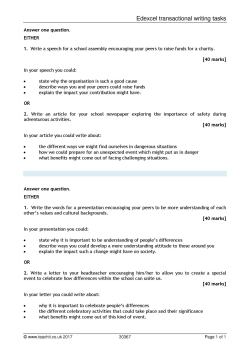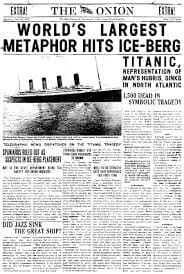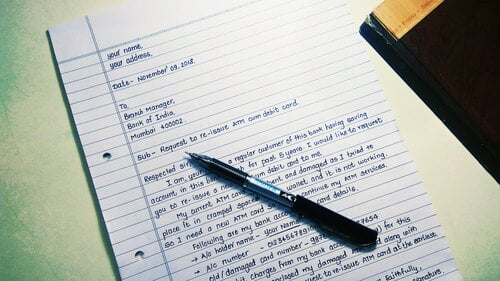

Transactional Writing Paper 2 Breakdown (Edexcel GCSE)
Here’s a breakdown of how to approach every single question on the Edexcel GCSE Transactional Writing Paper (Paper 2 on the English Language GCSE course). It’ll help you with revision, exam timings and generally getting organised!
If you find this lesson useful and you’re looking for more help with revision, you can access more of our English GCSE lessons .
Transactional writing is practical, so for this paper you will be either analysing the practical writing of others, or writing some practical texts yourself. This article will give you a clear approach to each question, so you know how to tackle it and the rough time frames for higher marked questions, so you know how long to spend on each answer.
Section A: Answer all questions, 1hr 20 mins
Q1 (2 marks).
- Information selection skill — look at the text in a very specific area and choose the right words or info for the focus of the question
- Make sure to only look at the lines given
- Make sure to give two separate ideas or points
- Tests explicit information
Q2 (2 marks)
- The wider focus then Q1
- Tests implicit information
Q3 (15 marks)
- Analyse how the writer uses language and structure to interest and engage readers — always the same question
- Analysis question — go into detail about the effects of language and structure — how does the writer use lang/struct? Why? — for each quotation, try to give at least 2 lines of effects, ideally 3
- PEE paragraphs — the point has to be your own idea about language or structure, then use several quotes, techniques, and effects to back it up
- You MUST talk about BOTH language and structure EQUALLY
- Aim for 3 full paragraphs
- When you choose evidence, be short and specific — use single-word quotations or short phrases, make sure all your evidence proves the idea or point for that paragraph
- For the top level, you have to use academic essay style language and a high, sensitive vocabulary
Q4 (1 mark)
- Make sure to only look at the lines given (if they give you lines)
- Tests explicit (obvious) information
Q5 (1 mark)
- Look at specific lines
- Identify a phrase (up to 6/7 words) — not a full sentence, not a single word
- Find the keywords or focus of the question
Q6 (15 marks)
- Presents you with an opinion — somebody’s personal viewpoint
- Asks you to evaluate the success of that opinion
- PEE paragraphs — the point has to be your own idea about the question, then use several quotes, techniques, and effects to back it up
- ‘Evaluate’ means find the things that are successful or particularly important for the question, and analyse how and why they are important
- You can briefly identify aspects that don’t work so well
- Provide an overall opinion yourself on how successfully the focus is achieved — is it totally successful or only partially? And why?
- Make sure to have an INTRO and CONCLUSION — just one sentence each, that summarise your findings
Q7a (6 marks)
- A focus of viewpoints / attitudes / opinions
- It will ask you to find similarities OR differences — only one of these
- Write PEE paragraphs — the point has to be your own idea about attitudes/viewpoints, then use several quotes, techniques, and effects to back it up
- 2 paragraphs are fine for this one
- Use comparative essay phrasing — e.g. similarly, likewise, in the same way, in comparison
- Try to think of comparisons that are not just basic/obvious/literal e.g. appearance — find ideas that are more complex or detailed
Q7b (14 marks)
- Full comparative essay — you should have a small comparative intro that summarises your findings and a small conclusion (1 sentence each)
- 3 middle paragraphs — all PEE but the Point is a comparative or contrast idea and each paragraph deals with BOTH texts at the same time
- The focus is always to do with ideas/ perspectives — the idea is a belief that is presented in the text; perspective is an opinion or viewpoints
- You can use some of your findings from 7a in this question if appropriate
- The very best answers will do a layered comparison/contrast on each point: On the surface, the texts seem similar because…. However, if we consider that…. They are in fact quite different.
Section B: Answer one question, 45 mins
- A question that asks you to do some form of practical writing — speech, letter, article is the most common
- Read through the two choices and choose the form and topic that you are most confident — not the most interesting or the one you like more (think about your confidence level for each question)
- 45-minute question but NOT 45 minutes writing:
- 5 mins planning
- 35 mins writing
- 5 mins checking
- Always address all of the bullet points and use them as guidance for structuring
- For top marks, you have to CLOSELY follow the conventions of the form — if it’s a letter, for example, it has to start and end like a letter and use letter writing techniques or conventions.
- For top marks, you need ALL pieces of punctuation : ; , . ? ! () … “” — you have to show accurate skill with using them in the right places
- Use accurate, complex grammar and vocab — check over grammar and spelling at the end!
- Stay very focused on the purpose of the writing and make sure every sentence contributes to that purpose.
- 4–5 paragraphs maximum — quality rather than quantity
- Analyse, expand and develop ideas as you go — don’t just give an idea and move on to the next one, stay longer and give more detail on each point according to your purpose
- As many techniques as you can — if it’s a persuasive purpose, use rhetorical devices as well as poetic devices. Make sure you use techniques that suit the conventions of your form.
Thanks for reading! If you found this lesson useful and you’re looking for more help with revision, you can access more of our English GCSE lessons .
Check what else I have prepared for you by clicking here .
Related Posts

Unseen Poetry Exam Practice – Spring

Unseen Poetry Exam Practice: The Man He Killed

How to Get Started with Narrative Writing

What do I need to do for AQA Language Paper 2?

How to do well in the AQA GCSE Paper 2 Exam!

AQA Power and Conflict: Example A* / L9 Grade Paragraph

Descriptive Writing: The train

Structuring Your Argument Effectively

Crafting a Strong Thesis Statement

The Impact of Technology on Language and Writing Styles
© Copyright Scrbbly 2022
Resources you can trust
Edexcel transactional writing tasks

All reviews
Have you used this resource?
Joan Sharpe
faria syeda
Resources you might like
Speech: Form
Choosing the Right Form
- A speech is an oral presentation given to an audience, often in a formal context.
- It could be informative, persuasive, argumentative or commemorative, depending on its purpose.
- The form of the speech should align with its purpose and the speaker’s intended impact on the audience.
Structuring a Speech
- A well-structured speech often follows a common format: an introduction, body and conclusion.
- The introduction engages the audience, presents the topic, and sets the tone for the speech.
- The body develops the speaker’s ideas in a logical order, often using topic sentences to guide the audience.
- The conclusion summarises key points, reinforces the speaker’s stance, and leaves a lasting impression on the audience.
Purpose and Content
- The content of the speech should be relevant and supportive to the speaker’s purpose.
- It could involve presenting facts in an informative speech , arguing a case in a persuasive or argumentative speech , or telling a story to inspire in a motivational speech .
- Proper research, credible sources, and organised points can support the speech’s content.
Language and Tone
- The language and tone of rhetoric should match the formality and context of the speech.
- For standard English, a neutral or formal tone may be appropriate in most occasions.
- In an informal or inspiring speech, the speaker may use a conversational tone, personal anecdotes or emotional appeals to engage with the audience.
Use of Rhetorical Devices
- The essence of a speech lies in the speaker’s rhetoric - their use of language to persuade or impress.
- Clever use of rhetorical devices such as anaphora , irony , and metaphor can draw the audience in.
- The selection of these devices should be purposeful and contribute to the impact of the speech.
Public Speaking Techniques
- Effective delivery techniques should accompany a good speech.
- Proper use of voice projection, pace, intonation, and body language can complement the content.
- Eye contact, gestures, and pauses for emphasis can enhance the speaker’s message and keep the audience captivated.
Adapting to Feedback
- Always be open to adapting and improving the speech based on feedback.
- Feedback might come from rehearsing in front of others or from self-evaluation.
- Changes for improvement could range from content modification to delivery improvements.
- International
- Schools directory
- Resources Jobs Schools directory News Search

How to Write an Effective Speech: GCSE Transactional Writing
Subject: English language learning
Age range: 14-16
Resource type: Lesson (complete)
Last updated
11 May 2019
- Share through email
- Share through twitter
- Share through linkedin
- Share through facebook
- Share through pinterest

Tes paid licence How can I reuse this?
Your rating is required to reflect your happiness.
It's good to leave some feedback.
Something went wrong, please try again later.
This resource hasn't been reviewed yet
To ensure quality for our reviews, only customers who have purchased this resource can review it
Report this resource to let us know if it violates our terms and conditions. Our customer service team will review your report and will be in touch.
Not quite what you were looking for? Search by keyword to find the right resource:

Transactional Writing
WHAT IS TRANSACTIONAL WRITING?
Transactional writing is an umbrella term that covers many different nonfiction writing genres.
The purpose of each transactional writing text type is to communicate ideas and information to others.
The purpose of a text can be defined as:
- To persuade
Sometimes two or more of these purposes will be combined in a single text type.

101 DIGITAL & PRINT GRAPHIC ORGANIZERS FOR ALL CURRICULUM AREAS

Introduce your students to 21st-century learning with this GROWING BUNDLE OF 101 EDITABLE & PRINTABLE GRAPHIC ORGANIZERS. ✌ NO PREP REQUIRED!!! ✌ Go paperless, and let your students express their knowledge and creativity through the power of technology and collaboration inside and outside the classroom with ease.
Whilst you don’t have to have a 1:1 or BYOD classroom to benefit from this bundle, it has been purpose-built to deliver through platforms such as ✔ GOOGLE CLASSROOM, ✔ OFFICE 365, ✔ or any CLOUD-BASED LEARNING PLATFORM.
WHAT ARE THE TRANSACTIONAL TEXT TYPES?
Any nonfiction writing genre that sets out to persuade, argue, advise, or inform can be classified as a transactional text type. Generally, they can all be grouped loosely under one of the following types:
- Article (Read our in-depth guide to writing an article here )
- Letter (Read our in-depth guide to letter writing here )
- Review (Read our in-depth guide to writing a book review here )
Each of these genres (and subsequent sub-genres) will follow specific conventions of language and structure.
What We’ll Look at in this Article
In this article, we’ll look at each of these transactional text types in more detail, as well as some other text types that don’t sit comfortably in any of the five broad genres listed above.
We’ll provide you with all the tools required to help students confidently approach writing any piece of transactional writing.
We’ll examine what students need to consider before they even begin putting pen to paper, breaking down each transactional writing genre into the specific criteria of language and structure.
Finally, we’ll provide some tools, tips, and techniques students can use to polish their transactional writing and help them achieve their text’s purpose.
HOW TO GET READY TO WRITE A TRANSACTIONAL TEXT
As with any writing task, preparation is key. Luckily, there’s a helpful acronym we can learn to keep the essential elements of transactional writing preparation clear in our minds: GAPS
Before beginning to write, students should fill in the GAPS by answering the following questions prompted by each letter in this acronym.
Let’s take a look:
G enre – What type of text are you being asked to write? What are the features of that genre?
A udience – Who are you being asked to write for? Is it an individual or a group?
P urpose – What are you trying to achieve in the text? Persuade, argue, advise, or inform?
S tyle – Is the text formal or informal? Relaxed or serious in tone? Simple or complex?
Usually, these questions can be quickly answered by closely reading the question or writing prompt.
In instances where the students have a freer rein on what they write, they must ensure that they have answered these questions clearly before beginning the writing process.
Failing to answer these questions definitively before starting to write will all but ensure the writing will lack clarity of purpose.

TRANSACTIONAL WRITING GENRES AND THEIR CRITERIA
Once a student has determined which writing genre they are creating, they need to ensure they have a firm grasp on the features of that genre.
Below, we’ll briefly examine some of the main criteria of each of the most common transactional writing genres. There isn’t space to cover each genre in detail here, as that’d require a complete dedicated article.
Luckily though, you’ll find comprehensive (and wonderfully written) articles on each writing genre on this very site!
Let’s gain a brief overview of some of the main criteria of the most common transactional text types.
1. HOW TO WRITE AN ARTICLE

The term ‘article’ covers a lot of ground here. We can expect to find articles in magazines, newspapers, and websites. We can also consider many forms of essays, such as persuasive essays for example, as articles.
STRUCTURE OF AN ARTICLE:
Articles are usually long-form pieces of prose writing on a specific topic. They can be balanced in their outlook considering many points of view , or they can present a very subjective opinion on the topic being written about.
The subjects that articles can explore are almost inexhaustible. Anything you can form an opinion on could make for the subject of an article. Some common topics for articles include:
- Entertainment
- Celebrities
- Current affairs
Articles tend to follow a basic 3-part structure of introduction, body paragraphs, and conclusion.
The introduction tries to grab the reader’s attention and usually outlines the main point of the article.
A series of body paragraphs usually follows that provides more detail on each of the main points covered in the article.
A final concluding paragraph then brings it all together at the end.
LANGUAGE OF AN ARTICLE:
To decide on the type of language to be used in an article, the writer will need to have first identified the audience and purpose of the text.
Regardless of which language register is used, it should be suited to the background of the target reader in terms of complexity and word selection.
Words should also be chosen to ensure the purpose of the article is achieved. For example, where an article is intended to be persuasive, emotional language may be selected. Whereas in an academic article on a historical topic, detached language devoid of emotional color may be more appropriate.
- Heading and subheadings
- Attention grabber or ‘hook’
- Introduction answering who, what, when, where, why, and how?
- Body paragraphs
- May contain pictures with captions
2. HOW TO WRITE A LEAFLET

Standard leaflets are made by folding a sheet of paper to create 2, 3, or more panels. They are often colorful and are usually distributed for free to provide information mostly on goods or services.
STRUCTURE OF A LEAFLET:
In leaflets, the layout and organization of the text are especially important. Usually, they’re printed on folded pieces of paper and card which have implications for how the information in a leaflet is presented.
Leaflets vary widely according to their purpose and the audience they are aimed at. Usually, they will employ subheadings to great effect to guide the reader’s eye through the various sections of information.
Also, information is frequently organized using bullet points and numbers to make instructions, for example, easier to follow.
LANGUAGE OF A LEAFLET:
When leaflets provide instructions, they’ll often use imperatives and the personal pronoun ‘you’.
As always, the language used will be suited to the audience. Where the audience is wide and varied, say, for a tourist attraction, the language will be simple and straightforward to make the information in the leaflet accessible to the widest possible audience.
The tone is often enthusiastic and reassuring, to inspire confidence in the information it contains.
LEAFLET WRITING KEY POINTS
- Easy to read with heading and subheadings
- A colorful and bold presentation style
- Makes an offer of product or service (or provides information)
- Often uses persuasive language
- Eye-catching
- Use of bullet points
- Short, snappy sentences
- Uses pictures and photographs
- May contain details on directions, map, opening times, price, phone no., etc.
THE ULTIMATE NONFICTION WRITING TEACHING RESOURCE

- 270 pages of the most effective teaching strategies
- 50+ digital tools ready right out of the box
- 75 editable resources for student differentiation
- Loads of tricks and tips to add to your teaching tool bag
- All explanations are reinforced with concrete examples.
- Links to high-quality video tutorials
- Clear objectives easy to match to the demands of your curriculum
3. LETTER WRITING

A letter is a written form of communication usually intended to be read by an individual or a small group of people. Only very rarely is it intended to be read by a large group of people, in which case it is usually referred to as an ‘open letter’.
While traditionally letters were written by hand on paper and delivered via the mail, today technology has given us many more options for personal communication including email, text messages, and various other forms of digital messaging.
STRUCTURE OF A LETTER:
Up until recently, letter writing was usually a fairly formal affair. There are standardized formulas for opening and closing letters which are still quite common. For example:
● If a letter opens with Dear Sir or Dear Madam (i.e. the name is unknown) it ends with Yours Faithfully
● If it opens with Dear Mr. Smith or Dear Mrs. Smith (i.e. the name is known) it ends Yours Sincerely .
And while these formal conventions can still apply, some types of text that we can group under the term ‘letter’ are much less formal in their style. Invitations and email are two prominent examples that employ a much looser approach to structure.
LANGUAGE OF A LETTER:
The language used in any type of letter will depend greatly on the audience it is intended for.
For example, while formal types of letters, such as a cover letter as part of a job application, will have a very professional tone, an invitation to a birthday party will likely have a warm and friendly tone.
Emails are used for a wide variety of purposes these days, and even though they can still be used in some more formal type contexts, in general, they are much more conversational in tone than letters.
LETTER WRITING KEY POINTS:
- For formal letters, your address and the date in the top right corner and the recipient’s address to the left
- Opens with an appropriate greeting (e.g. Dear Sir/Madam, Dear Mr X / Ms X, Hi, etc)
- Main body paragraphs.
- Ends with appropriate closing (e.g. Yours Faithfully, Yours Sincerely, Take Care, etc)
4. HOW TO WRITE A REVIEW

Traditionally, when we think of reviews many of us think of book and movie reviews. There are, of course, many other types of reviews to consider.
These days people read and write reviews on almost any product or service, from hotels to restaurants. For example, we might read a review of a theater show before deciding whether to go or a computer game before deciding on buying it.
STRUCTURE OF A REVIEW:
Usually, a review will open with a statement about what is being reviewed before summing up the writer’s opinion. The remainder of the review will be dedicated to explaining why the writer arrived at the conclusion they arrived at with, of course, close reference to the thing being reviewed.
LANGUAGE OF A REVIEW:
When the review is positive, the writer will opt for more positive language, making for a more upbeat experience for the reader. The reverse is true for negative reviews.
The tone of a review will be particularly obvious in the choice of adjectives chosen by the writer.
As the review is subtly trying to influence the reader’s perception of the thing reviewed, it’s important that the reader trusts the writer and this can be achieved by the writer building rapport with the reader.
One effective way to achieve this is through the use of humor, though whether or not this is appropriate will depend particularly on the specific purpose of the review and the nature of the intended audience.
KEY POINTS OF WRITING A REVIEW
- States what is being reviewed (book, movie, article, etc)
- Overview of material
- Body paragraphs explore positives and negatives
- The conclusion summarizes and expresses an opinion
- Provides either a negative critique or a positive recommendation.
5: HOW TO WRITE A SPEECH

Speeches are made to do one of 4 things: to inform, to instruct, to persuade, or to entertain. They are made on all sorts of formal and informal occasions ranging from political campaign speeches to birthday party toasts.
STRUCTURE OF A SPEECH:
Speeches most often follow a simple 3-part structure:
- An engaging and motivating opening
- Strong, well-structured arguments
- A powerful and memorable conclusion
LANGUAGE OF A SPEECH:
A speech should deliver arguments with clarity and consistency. The speaker must be engaging and able to connect with the audience on an emotional level.
So as not to alienate the audience, it is necessary to choose language in tune with the make-up of the audience.
The purpose of many speeches is persuasion and so persuasive devices should be used such as rhetorical questions, objection handling, and emotive language.
KEY POINTS OF SPEECH WRITING
- Opens with a welcoming statement or greeting (Ladies and gentlemen, Dearly beloved, Teachers and classmates, etc)
- Outlines what speech will be about (Today, I will speak to you about…)
- Body of speech makes 3 or 4 points and expands upon each point
- Arguments handle objections
- Conclusion summarizing main points
- Possible call to action at the end
- Thank the audience.
OTHER TRANSACTIONAL TEXTS TO CONSIDER
Again, the criteria above are far from exhaustive and each genre is worth studying in detail before writing – the articles on this site are a great place to start.
Remember too, the features above are general and each genre has a host of subtypes that have their own specific requirements that may not be listed in the bullet points above.
Also, while the genre of writing will inform the style and tone of the text, a lot depends on the purpose and the audience. This will be decided by the student in the preparation phase by answering the GAPS questions listed earlier in this article.
Now, students understand how to prepare to write, how to structure their writing, and which language register to use, it’s time to make sure they possess the necessary skills to get the work done.
WHAT KEY SKILLS ARE NEEDED TO WRITE A TRANSACTIONAL TEXT?
Well, as discussed already, transactional writing texts cover a wide range of genres, serving many purposes, and are directed toward a variety of audiences.
Therefore, the list of techniques and skills described below will not apply in every single transactional text a student writes.
Once the student has mastered each of the skills and techniques below, they will need to apply their understanding of each writing context to decide which is best suited to their current needs.
The acronym AFOREST will help students to remember the specific writing techniques.
Let’s take a look at each in turn:
A – ALLITERATION & APPEAL
Alliteration refers to the repetition of an initial consonant sound in a series of words. Tongue twisters are an easy way to illustrate the concept, e.g.,
P eter P iper p icked a p eck of p ickled p epper.
We often see alliteration used in texts that employ headlines as the technique helps grab attention and engage the reader. It can also, of course, be used within the body of the text to help draw attention to a concept or idea.
Appeal is a reminder to consider the audience the text is intended to appeal to, as this will greatly affect the tone of the writing.
It will also inform the pronouns the writer chooses to use in their text.
For example, in a speech where the writer is directly addressing their audience, they may frequently use personal pronouns directly addressing the audience such as you and we .
For example:
Instead of… “Action must be taken to prevent this.”
The student writes… “We must take action to prevent this.”
F – FACTS
Facts are an important tool of persuasion and can come in many forms. Essentially, facts refer to any verifiably true statement. Statistics are one convincing tool of persuasion to support factual statements.
Whatever guise facts come in, they can be used to inform or entertain as well as persuade the reader.
O – OPINION
Opinion refers to the sharing of a personal point of view. Opinions bring life to a piece of writing.
While it may not be appropriate to express a personal opinion in some contexts, many types of transactional text would be incomplete without the inclusion of the writer’s opinion. For example, a persuasive essay or a movie review.
Often, a text will open with an assertion of the writer’s opinion with the rest of the piece focused on supporting that opinion to persuade the reader to share the writer’s point of view.
The difference between a statement of fact and one of opinion is illustrated in the following two sentences:
Brazilian Jiu Jitsu is a very popular combat sport. (Fact)
Brazilian Jiu Jitsu is the greatest of all combat sports. (Opinion)
R – REPETITION & RHETORICAL QUESTIONS
Repetition repeating certain words or phrases in a text is an effective means of highlighting a message or an idea, as well as reinforcing it in the mind of the reader. Repetition can be used to not only to bring rhythm and a certain poetry to a text, but it can bring clarity too.
For example,
“Mankind must put an end to war – or war will put an end to mankind.”
— John F. Kennedy
Rhetorical Questions are questions that are asked, but no answer is expected. Usually, the answer will be either implied or obvious to the audience. They are frequently used in speeches and persuasive texts such as advertisements.
For examples,
“Why pay more?”
Rhetorical questions are asked for the effect they create, rather than any attempt to elicit an answer. They can be a very persuasive tool to have in any writer’s arsenal.
E – Emotive Language & Exaggeration
Emotive Language is a powerful tool of persuasion. Emotive language in a text can be used to incite strong feelings in the reader.
Whether these feelings are feelings of joy, sorrow, disgust, or desire, writers often use this type of language to evoke a desired reaction in the reader and incite them to take a particular course of action.
Emotive language is commonly understood in contrast to objective, factual writing. This type of language makes a contention or argument, but in a way, that appeals to the reader’s feelings.
For example, if the writer is arguing that there should be no restrictions on business opening hours, they might write the following:
“Forcing businesses to close will steal money from the pockets of our poorest workers. It will steal bread from the hungry mouths of our children.”
Exaggeration is sometimes known as hyperbole and in this context refers to the making of intentionally over-the-top statements to intensify the impact of an argument.
Instead of saying school closures will create problems for students, parents, and teachers alike, we might make a statement like:
“School closures will be the end of the world!”
S – Statistics
Statistics , along with percentages and other numbers, are used as supporting evidence for facts.
“The beginning of the week is an extremely stressful time for many people. So much so that the risk of a heart attack for adult men is about 20% greater on Mondays and 15% greater for adult women.”
T – The Rule of Threes
Three is the magic number. Our brains love patterns as they help us make meaning and help make that meaning memorable. We see it in practice in many common phrases.
“Cool, calm, collected”
“Blood, sweat and tears”
“Location, location, location”
While cliché should usually be avoided, students can come up with their own patterns following the rules of 3 to make their writing more memorable.
WRITING CHECKLIST & RUBRIC BUNDLE FOR ALL TEXT TYPES

⭐⭐⭐⭐⭐ (92 Reviews)
Transaction Complete
When understood well, the above concepts, strategies, and techniques will ensure that student writers can confidently and competently produce a strong piece of transactional writing in any genre.
As their experience and abilities grow, students will quickly be able to recognize the purpose of any writing prompt and accurately assess their prospective audience to help fine-tune their language register.
Once they’ve selected the appropriate criteria, they’ll be able to choose suitable tools and techniques to produce a polished piece of writing that fulfils all intended objectives.
All that’s needed now is practice – and plenty of it!
OTHER GREAT ARTICLES RELATED TO TRANSACTIONAL WRITING

How to write a letter

How to write a text response

How to Write a Descriptive Text

How to Write a Compare and Contrast Essay

IMAGES
VIDEO
COMMENTS
GCSE; Edexcel; Non-fiction and transactional writing - Edexcel Writing a speech. Non-fiction texts are those that deal with facts, opinions and the real world. Many non-fiction texts follow ...
Underline key words from the question and blurb. Underline the audience you will be delivering your speech to. Decide on your "voice" and point of view. Write a one-sentence statement that summarises your point of view. Note down the points you can develop to support your point of view.
Revision notes on How to Write a Speech for the Edexcel IGCSE English Language A: Paper 1: Non-fiction Texts and Transactional Writing syllabus, written by the English Language A: Paper 1: Non-fiction Texts and Transactional Writing experts at Save My Exams. ... GCSE Other Subjects. Edexcel Arabic. Past Papers; Edexcel Art, Craft & Design.
Here's a breakdown of how to approach every single question on the Edexcel GCSE Transactional Writing Paper (Paper 2 on the English Language GCSE course). It'll help you with revision, exam timings and generally getting organised! ... A question that asks you to do some form of practical writing — speech, letter, article is the most common;
Exam preparation. This supportive resource is designed to develop GCSE students' confidence and exam skills in preparation for the Edexcel GCSE English Language Paper 2 question, focusing on transactional writing. There are five exam-style questions, covering a range of non-fiction transactional forms including magazine articles and letter ...
PowerPoint and Word doc available here: hhttps://www.tes.com/teaching-resource/resource-13031746A revision video on the SPEECH for the paper 2 transactional ...
Buy my revision guides in paperback on Amazon*:Mr Bruff's Guide to GCSE English Language https://amzn.to/2GvPrTV Mr Bruff's Guide to GCSE English Literature...
In this video ETETutor discusses a GCSE English Language: Transactional Writing exam style question: this time it's a speech! You can pause and complete task...
Age range: 14-16. Resource type: Assessment and revision. File previews. docx, 16.65 KB. A collection of seven titles covering speech/talk, formal and informal letters, guide, report, review and article that are similar in style to GCSE examination titles for transactional writing. Gratis - enjoy! Creative Commons "NoDerivatives".
Writing for purpose and audience: Arguments and persuasive texts. Resource type. Student activity. Revision. Exam preparation. A selection of practice questions for Paper 2 Section B of the Edexcel GCSE English Language paper. Activities include writing a speech for a school assembly and writing an article for the school newspaper. 22.52 KB.
A speech is an oral presentation given to an audience, often in a formal context. It could be informative, persuasive, argumentative or commemorative, depending on its purpose. The form of the speech should align with its purpose and the speaker's intended impact on the audience. Structuring a Speech. A well-structured speech often follows a ...
This video will support you in understanding how to write a strong GCSE speech. It includes:The mark schemeThe basic skillsA RECAP of persuasive writing tech...
How to Write an Effective Speech: GCSE Transactional Writing. This lesson is carefully scaffolded to ensure that students struggling to achieve a grade 5 are fully supported in their learning. Exemplar material is offered, regular reinforcement of learning and steady building of skills are all used to ensure all students are able to write a ...
For formal letters, your address and the date in the top right corner and the recipient's address to the left. Opens with an appropriate greeting (e.g. Dear Sir/Madam, Dear Mr X / Ms X, Hi, etc) Main body paragraphs. Ends with appropriate closing (e.g. Yours Faithfully, Yours Sincerely, Take Care, etc) 4.